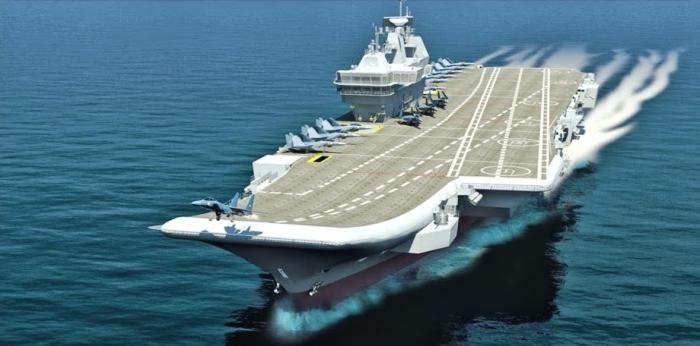The Aircraft Carriers of the Indian Navy
How's the Josh lads?
Hope you all are doing wonders, in today’s blog we are going to tell you everything about the Aircraft carriers of the Indian Navy.
This blog is definitely going to help the Navy aspirants in the long run of their career.
An Aircraft carrier is basically a large vessel that could shelter Aircraft on it, that could be further used for reconnaissance and sabotage over enemies in the ocean.
Thus an aircraft carrier plays a very crucial factor adding up to the strength of the Navy of any country.
The Indian Navy basically has three Aircraft carriers one of which is active on the duty and the two are under advancement.
It is due to these aircraft carriers Indian shows its dominance of the Navy on the Indian Ocean over arch rivals like Pakistan and China.
INS Viraat:
- The INS Viraat (which in Sanskrit basically means “Giant”) was a Centaur class Aircraft carrier of the Indian Navy.
- Viraat was the flagship of the Indian Navy before INS Vikramaditya was commissioned in 2013.
- The ship was completed and commissioned in 1959 as the Royal Navy's HMS Hermes, and decommissioned in 1984.
- INS Viraat was basically commissioned into the Indian Navy on 12 May 1987 and served for almost 30 years.
- The last British-built ship serving with the Indian Navy, she was the oldest aircraft carrier in service in the world.
- On 23 July 2016, Viraat sailed for the last time under her own power from Mumbai to Kochi, where she was dry-docked and prepared for decommissioning.
- On 1 November 2018, the Maharashtra cabinet approved the conversion of Viraat into India's first moored maritime museum and marine adventure center.
- It would be located near Nivati, Sindhudurg district. The response of the Indian Navy is not yet known.
- Characteristics of INS Viraat are given below:
|
Class and type: |
Centaur class |
|
Displacement: |
23,900 tons standard 28,700 tons full load |
|
Length: |
226.5 m (743 ft.) |
|
Beam: |
59.8 meters (196 ft.) |
|
Draught: |
48.78 m (160.0 ft.) |
|
Speed: |
28 knots (52 km/h) |
|
Range: |
6,500 mi (10,500 km) at 14 knots (26 km/h) |
|
Complement: |
·Maximum 2,100; ·1,207 ship's crew, 143 aircrew |
|
Sensors and |
·1 × BEL/Signal RAWL 02 air radar ·1 × RAWS 08 air/surface radar ·2 × BEL Rashmi navigation radars ·EL/M-2221 STGR fire control radar · Plessey Type 904 radar ·FT 13-S/M Tacan system |
|
Armament: |
2 × 40 mm Bofors AA guns, 16 × Barak SAM VL cells, 2 × twin AK-230 CIWS |
|
Aircraft carried: |
·Up to 26 aircraft, including ·16 * Sea Harrier FRS51 ·4 * Sea king Mk.42B-C ·2 *HAL Chetak |
INS Vikramaditya:
- INS Vikramaditya (which basically means "Brave as the Sun") is a modified Kiev-class vessel.
- It entered into service with the Indian Navy in 2013.
- It has been renamed in honor of Vikramaditya, basically a legendary emperor of Ujjain, India.
- Originally built as Baku and commissioned in 1987, the carrier served with the Soviet Navy and later with the Russian Navy (as Admiral Gorshkov) before being decommissioned in 1996.
- The ship successfully completed her sea trials in July 2013and aviation trials in September 2013.
- She was commissioned on 16 November 2013 at a ceremony held at
- On 14 June 2014, thePM of India formally inducted INS Vikramaditya into the Indian Navy and dedicated her to the nation.
- General Characteristics are given below:
|
Class and type: |
Modified Kiev-class aircraft carrier |
|
Displacement: |
45,400 tons of loaded displacement |
|
Length: |
283.5 meters (930 ft.) (overall) |
|
Beam: |
59.8 meters (196 ft.) |
|
Draught: |
10.2 meters (33 ft.) |
|
Decks: |
22 |
|
Installed power: |
6 turbo alternators and 6 diesel alternators which generate 18 MWe |
|
Propulsion: |
8 turbo-pressurized boilers, 4 shafts, 4 geared steam turbines, generating 180,000 horsepower (134,226 kW) |
|
Speed: |
+30 knots (56 km/h) |
|
Range: |
13,500 nautical miles (25,000 km) at 18 knots (33 km/h) |
|
Endurance: |
45 days |
|
Complement: |
110 officers and 1500 sailors |
|
Sensors and |
Long range Air Surveillance Radars, LESORUB-E, Resistor-E radar complex, CCS MK II communication complex and Link II tactical data system |
|
Armament: |
·4 × AK-630 CIWS ·Barak 1 ex INS Godavari ·Barak 8 (LRSAM) |
|
Aircraft carried: |
·Maximum of 36 aircraft including 26 × Mikoyan MiG-29K multi-role fighters10 × Kamov Ka-31 AEW&C and Kamov Ka-28 ASW helicopters |
|
Aviation facilities: |
·14 degree ski-jump ·Three 30 m wide arrester gears and three restraining gears. |
INS Vikrant:
- The Vikrant class (formerly Project 71 Air Defence Ship (ADS) or Indigenous Aircraft Carrier (IAC)) is a class of Aircraft carrier being built for the Indian Navy.
- The class basically represents the largest warships and the first aircraft carriers to be designed and built in India.
- Preparations for building the lead vessel of the class, INS Vikrant, started in 2008, and the keel was laid in February 2009.
- The carrier basically was floated out of it drydock on 29 December 2011 and launched on 12 August 2013.
- The scale and complexity of the project caused problems which delayed the commencement and timeline of construction for the carrier.
- Technical difficulties, the cost of refitting the Russian-built carrier Vikramaditya, and billions in cost overruns delayed plans for the first of the vessels to enter service, with completion projected for 2023.
- The first ship of the class, Vikrant, displaces about 40,000 metric tons (39,000 tons), is 262 meters (860 ft.) long and has a tailored air group of up to thirty aircraft.
- General characteristics of INS Vikrant:
|
Class and type: |
India’s Indigenous Vikrant class. |
|
Displacement: |
·INS Vikrant: 40,000 tonnes ·INS Vishal: 65,000 tonnes |
|
Length: |
262 meters (860 ft.) |
|
Beam: |
62 meters (203 ft.) |
|
Draught: |
8.4 meters (28 ft.) |
|
Decks: |
2.5 acres (110,000 sq ft; 10,000 m2) |
|
Installed power: |
6 turbo alternators and 6 diesel alternators which generate 18 MWe |
|
Propulsion: |
28 kn (52 km/h) |
|
Speed: |
28 kn (52 km/h) |
|
Range: |
8,000 nmi (15,000 km) |
|
Complement: |
1400 personnel |
|
Sensors and |
·1 × Selex Ran 40 L ·L-band early warning |
|
Armament: |
· 4 ×Otobreda dual purpose cannons ·Barak 1 and Barak 8 surface-to-air missile launchers (2 x 32 cells VLS) ·AK-630 CWS |
|
Aircraft carried: |
|
Lads hope that this blog had given an answer to various questions that had ever popped up in your minds regarding the Aircraft carriers.
Sure this will help you in long run.
Stay tuned to DDE.
Jai Hind.






 Order Now on Amazon
Order Now on Amazon
